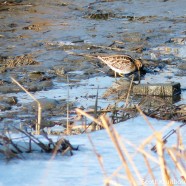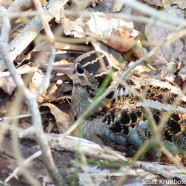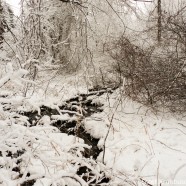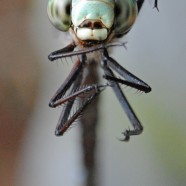Wilson’s Snipe
As the snow recedes and the marshes, rivers, wetlands and wet meadows thaw, birds like this Wilson’s Snipe can finally trickle back to the north. You can’t bury your bill in the frozen earth, but thankfully for them the end of the winter’s grip is here. This late afternoon bird is being heated by that warming sun, knowing its path back to its breeding grounds will soon be easier.
Read MoreAmerican Woodcock in March Snow
I was delighted to find this American Woodcock (Scolopax minor) feeding in the exposed leaf litter and mud thanks to the warm, flowing spring and expansive wetlands in my yard today after about six more inches of snow fell yesterday and early this morning. Note the muddy end of this shorebird’s bill showing it had been busy foraging throughout the day in this video… …and the photos below: This well-known spring species dances on the ground while foraging and in the sky while courting every March, though this year the displays may be a little later than usual. The sun is so...
Read MoreHidden American Woodcocks
March is the month for the American Woodcock (Scolopax minor) as the species heads north to (hopefully) unfrozen earth, with males arriving as quickly as they can to set up on the best territory for their legendary display flights. This year’s polar lock on the region may slow them down as feeding will be very difficult, if not impossible, for another week or two at least. Open fields and meadows adjacent to wetlands, marshes and scrubby/shrubby lands are good places to wait for their evening aerial dances later in the month. I photographed these two birds in the early winter, long...
Read MoreSnowy Wetlands
If you can manage to discover any open wetlands in January where water still flows you may be in a store for a treat when it comes to some of the hidden birds in and around this habitat. Natural springs may run even when the temperature is well below freezing. Some streams find a way to keep warm and draw in wildlife, too. The tiny Winter Wren can be found in a place like this, hopping from rock to rock. One may turn up a very well hidden American Woodcock using the exposed earth to search for earthworms. Ruby-crowned Kinglets may be feeding at eye-level as they hope for insects in the air...
Read MoreCanada Darner (Aeshna canadensis)
Have you ever taken an up close look at a dragonfly? We did at this Canada Darner (Aeshna canadensis) we found patrolling the edge of the pond at College Lodge around this time last year. As you can see, Canada Darners have large compound eyes, providing excellent vision needed for hunting on the fly. While you are enjoying the autumn-like days soon to come, keep an eye out for this spectacular dragonfly species and more emerging and migrating through the area.
Read More








